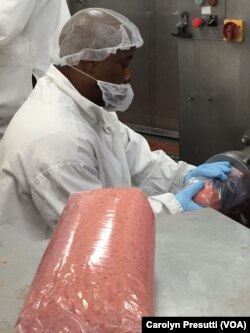New federal statistics will be released next week on the prison population in the United States, which is larger than that of any other nation in the world.
According to the International Centre for Prison Studies, almost half of the world's prisoners — 2.24 million — are held in the United States.
The prison population began growing dramatically in the 1980s when politicians promoted a "get tough on crime" stance to try to curb the influx of crack cocaine into the country. Their response was to implement mandatory minimum sentences — typically, decades of incarceration for drug offenders and a "three strikes, you're out" rule for repeat offenders.
Some lawmakers want to keep mandatory minimums, but others are prescribing shorter sentences and prison employment programs as steps that can be taken to ease the burden on a prison system that is "busting at the seams."
Mandatory sentences
Gary Cannon got 25 years for selling heroin.
"My mother was murdered by somebody," said Cannon, an inmate at the Maryland Correctional Institution in Hagerstown. The killer "got only five years more than me, and all I did was sell drugs and got caught with drugs. Now, I’m not minimizing my charge. I deserved some time. I got caught doing something illegal. But at the same time — murder and a drug charge?"
When mandatory minimum sentences began to rise in number, nonviolent offenders like Cannon would be placed in the same prison populations as hardened criminals. Warden Rich Dovey, who has been at the Maryland facility for nearly 30 years, remembers such situations in the early years.
“It would basically be survival of the fittest, so we would have a lot more instances of violence,” he said.
Cannon has learned a trade while behind bars: He works as butcher and packer in the facility's meat plant. The plant processes $7.5 million worth of meat products annually. Cannon said he's thankful he will have this skill to take with him when he's released.
“If an individual is just placed inside a prison and never addressed, then he’s the same individual as when he goes back out," he said. "He’s never had his issues addressed. He’s just been sent away for a while. So the moment he’s released back into the same society where drugs are abundant, he falls right back.”
Recidivism
Work programs like the one in the Hagerstown facility's meat plant have proven successful in lowering incarceration numbers. The recidivism rate from Maryland’s prison’s industries is one of the lowest in the country — only one in four inmates returns to prison, compared with two out of three nationally.
Dovey says prisons are changing direction.
"We’re all about change," he said. "Just because we did something in the '80s and '90s doesn’t mean that it was correct — we based it on the laws that were in place at the time and the people who were in charge of the country at the time. But as we look at things and we realize we aren’t gaining anything by living with those rules and regulations that we lived by back then, we need to restructure. Our prison system is busting at the seams."
Sergeant Willie Vinson, a corrections officer, is a 24-year veteran of the state's corrections department. Many of the 2,000 inmates at the Maryland Correctional Institution were here long before he began working there.
"My gosh, don’t you think 15 to 20 years is enough incarceration for somebody?" he asked.
Vinson said he thought some inmates should be released to ease overcrowding, while others should be locked up longer. He said no one should ignore the fact that even nonviolent drug dealers affect the lives of others.
"When he hands the drugs out to somebody and they buy them from him, not only does that affect that person, that affects that person’s family and friends around him to when they become addicts," Vinson said. "So is the sentence worth it?" He held his hands up and shrugged.
Fighting over tactics
There’s currently a fight on Capitol Hill between those who want to add more work programs and those who want to keep mandatory minimum sentences. Republican Senator Mike Lee of Utah has introduced the Smarter Sentencing Act of 2015 to try to combine both approaches.
"When we start talking as I do in the Smart Sentencing Act about reducing the 20-year to a 10, the 10-year to a five-year and the five-year to a two, that allows us to free up prison space," he said. "That doesn’t change the statutory maximum offenses. Those remain the same, so judges would retain discretion.
"Being tough on crime doesn’t always entail perpetually increasing the amount of time a prisoner has to spend in prison. We want to make sure that people spend exactly as much time as they need to spend in order to face a punishment for what they’ve done wrong," said Lee.
"But we don’t want them in there any longer than they need to be in there, because they could be out being productive members of society," he said.
Another bill in the Senate will look at lowering some mandatory sentences in favor of raising others. It won’t help Cannon, but it could help those who come through the barbed-wire fences and steel gates behind him.















